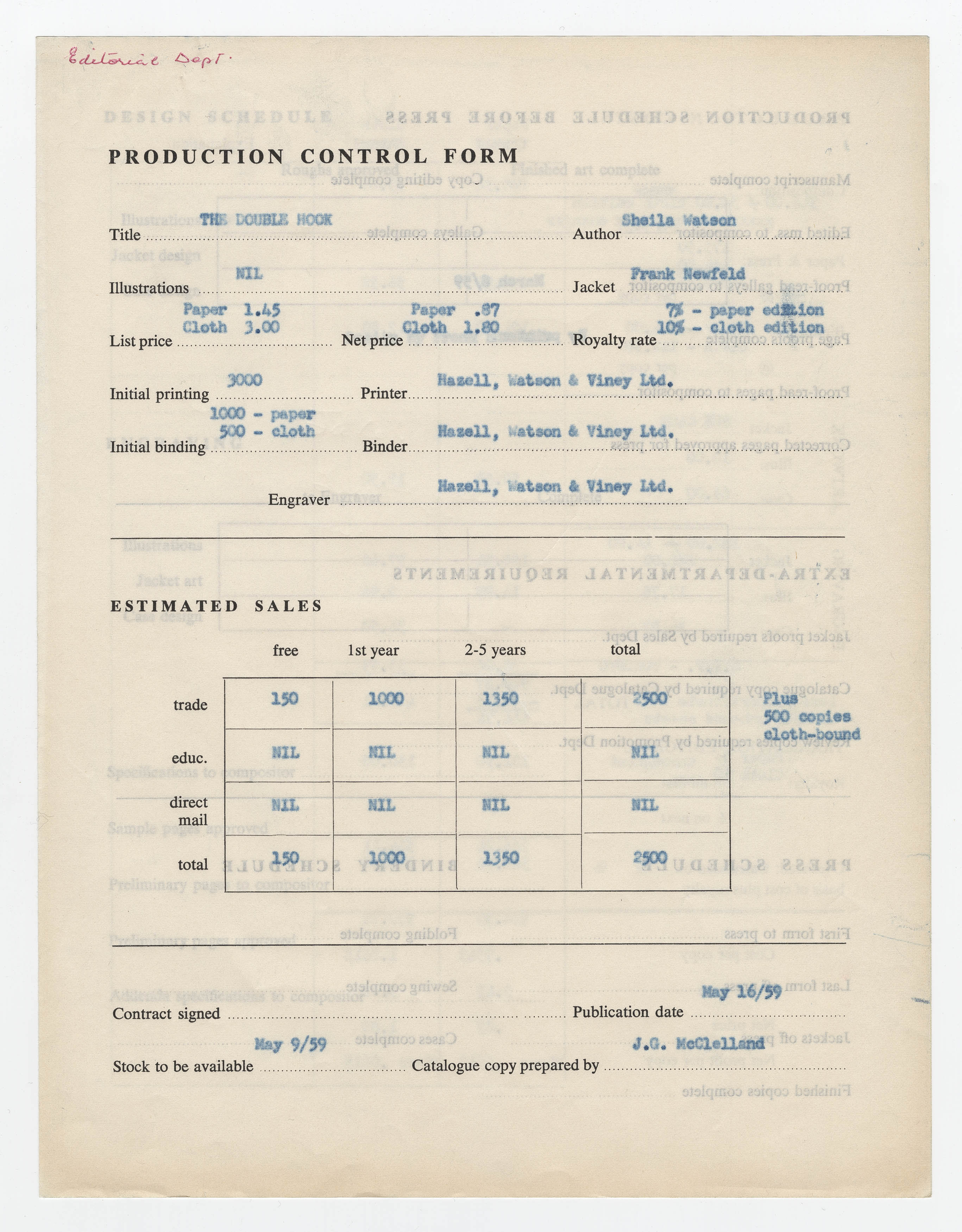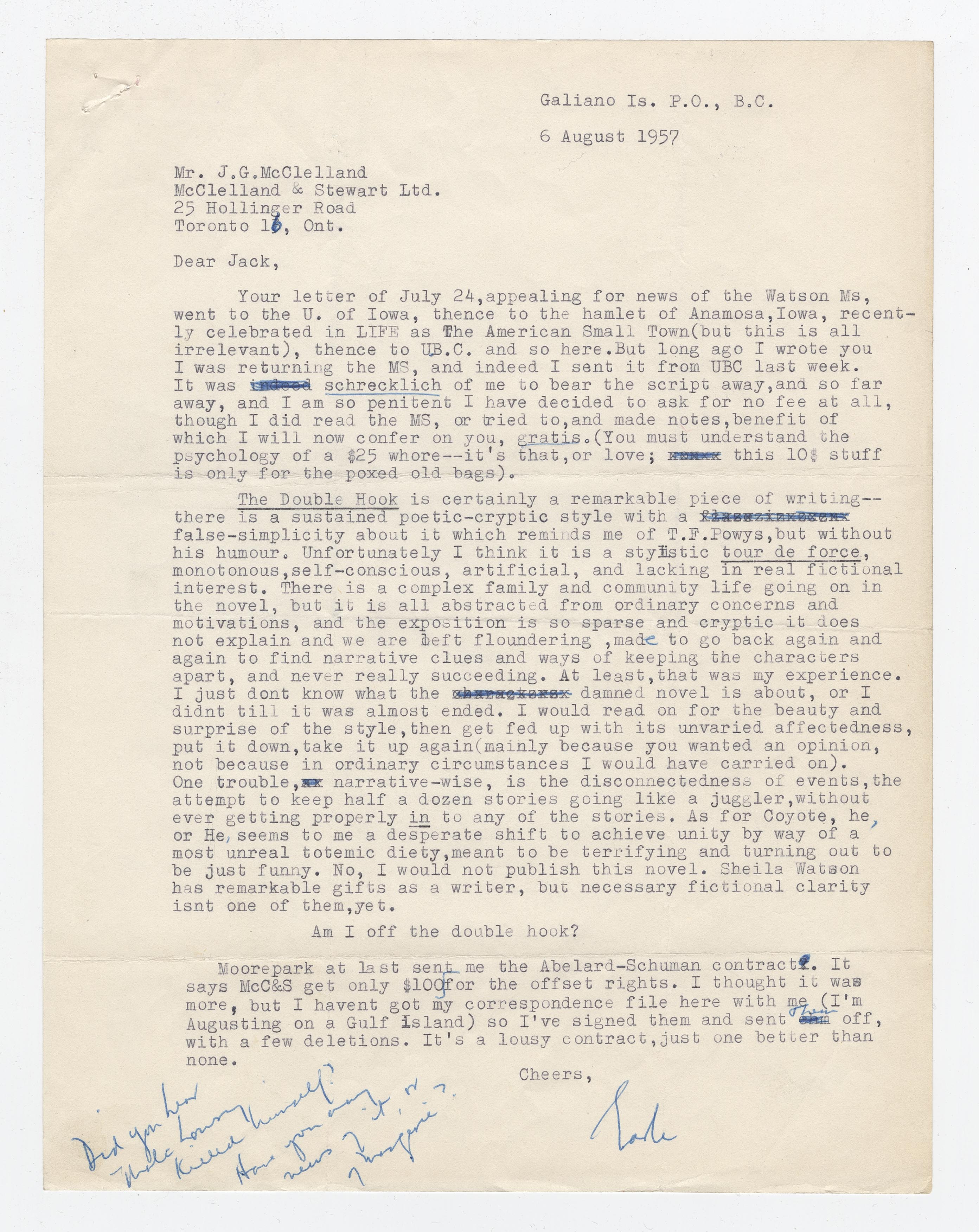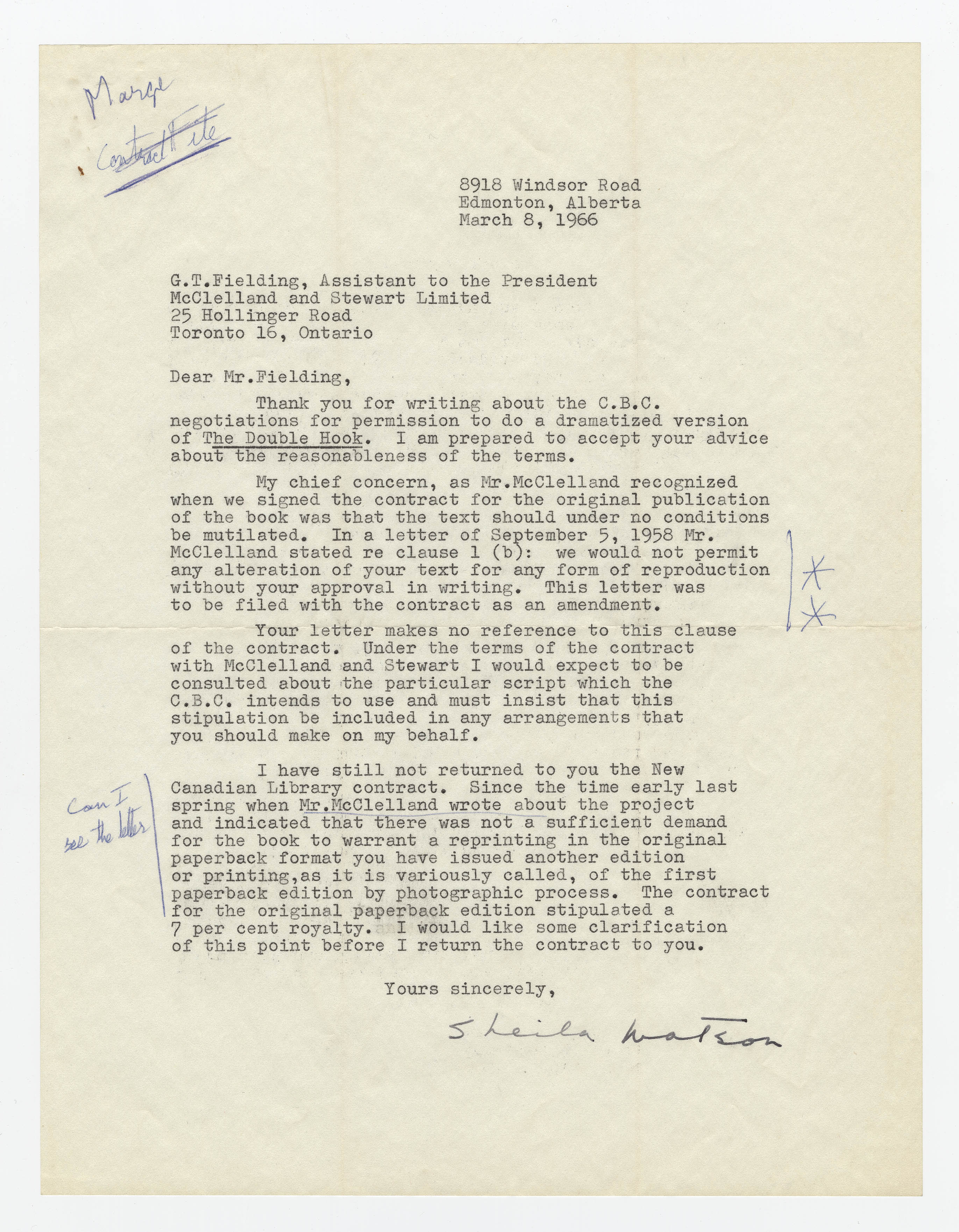How Sheila Watson’s The Double Hook Caught On
Jordan Rendell Smith, Queen’s University
 Though he initially had no idea what it was about, Jack McClelland’s gamble in publishing Watson’s The Double Hook paid off, and all 3,000 copies of the initial print run were sold. Supporters such as Watson’s University of Toronto doctoral supervisor and media guru Marshall McLuhan, as well as Yale formalist Cleanth Brooks saw it as a literary landmark ushering the Canadian novel out of its regional confines. Professor Fred Salter, author of an explanatory (and unabashedly promotional) essay accompanying the manuscript, hyperbolically called it “the most brilliant piece of fiction ever written in Canada”. He convinced McClelland, who tirelessly promoted the novel to international publishers. Debuting in M&S’s New Canadian Library (NCL) series (founded in 1958 to supply home-grown “classics” to the university and college market), the novel would go on to many subsequent editions and international translations, including publication as the Swedish Dubbelkroken in 1963, the French Sous l'oeil de coyote in 1976, and the Italian Il doppio amo in 1992.
Though he initially had no idea what it was about, Jack McClelland’s gamble in publishing Watson’s The Double Hook paid off, and all 3,000 copies of the initial print run were sold. Supporters such as Watson’s University of Toronto doctoral supervisor and media guru Marshall McLuhan, as well as Yale formalist Cleanth Brooks saw it as a literary landmark ushering the Canadian novel out of its regional confines. Professor Fred Salter, author of an explanatory (and unabashedly promotional) essay accompanying the manuscript, hyperbolically called it “the most brilliant piece of fiction ever written in Canada”. He convinced McClelland, who tirelessly promoted the novel to international publishers. Debuting in M&S’s New Canadian Library (NCL) series (founded in 1958 to supply home-grown “classics” to the university and college market), the novel would go on to many subsequent editions and international translations, including publication as the Swedish Dubbelkroken in 1963, the French Sous l'oeil de coyote in 1976, and the Italian Il doppio amo in 1992.
The Double Hook manuscript, written c. 1952-54 in Calgary and revised during a year-long stint in Paris, had met with rejection by UK publishers throughout the 1950s: T.S. Eliot at Faber & Faber, C. Day Lewis at Chatto & Windus, and Rupert Hart-Davis all turned it down.  However, McClelland saw its potential in the Canadian market and sought the opinion of M&S-published poet Earle Birney. Writing from his remote Galiano Island summer cabin, Birney criticized the novel as “monotonous, self-conscious, artificial, and lacking in real fictional interest.” He confessed: “I just don’t know what the damned novel is about,” but admitted that its “sustained poetic-cryptic style” made it “certainly a remarkable piece of writing.” He ultimately decided against publication, citing the novel’s lack of “fictional clarity,” and ended with his usual candour, asking McClelland: “Am I off the double hook?”
However, McClelland saw its potential in the Canadian market and sought the opinion of M&S-published poet Earle Birney. Writing from his remote Galiano Island summer cabin, Birney criticized the novel as “monotonous, self-conscious, artificial, and lacking in real fictional interest.” He confessed: “I just don’t know what the damned novel is about,” but admitted that its “sustained poetic-cryptic style” made it “certainly a remarkable piece of writing.” He ultimately decided against publication, citing the novel’s lack of “fictional clarity,” and ended with his usual candour, asking McClelland: “Am I off the double hook?”
Likewise, American publishers that McClelland hoped would expose the novel to audiences outside of Canada declined publication. Harcourt-Brace, Knopf, Atheneum, Random House, and New Directions agreed that although The Double Hook was not without merit, they were not interested in losing money on it.  “I’m afraid we simply can’t go along with Professor Salter in the matter of Sheila Watson’s THE DOUBLE HOOK,” wrote Alfred A. Knopf Sr. to McClelland “We don’t feel it could conceivably sell, and it doesn’t seem to us to be anything like distinguished enough to justify Salter’s hoop’la.” McClelland responded that, though he agreed there was “almost no market for the book,” he was “still impressed with Salter’s opinion,” however “biased” it may have been. At the time, McClelland even admitted to Salter: “I don’t quite know what we shall do with it. I am fairly certain now that it would mean a substantial loss to us were we to publish it on our own in Canada”.
“I’m afraid we simply can’t go along with Professor Salter in the matter of Sheila Watson’s THE DOUBLE HOOK,” wrote Alfred A. Knopf Sr. to McClelland “We don’t feel it could conceivably sell, and it doesn’t seem to us to be anything like distinguished enough to justify Salter’s hoop’la.” McClelland responded that, though he agreed there was “almost no market for the book,” he was “still impressed with Salter’s opinion,” however “biased” it may have been. At the time, McClelland even admitted to Salter: “I don’t quite know what we shall do with it. I am fairly certain now that it would mean a substantial loss to us were we to publish it on our own in Canada”.
 Rejecting the advice of his American publishing associates and Birney, McClelland changed his mind, “finally decided that this was all nonsense, and published it here anyway”; he wrote Watson with an offer to publish despite the “general consensus of opinion that it is not a sound commercial publishing risk”. The McClelland-Watson correspondence is a model of publisher-author kindness as evidenced in his letter of 30 March 1959. In answer to Watson’s ongoing fears that her novel was a “financial liability”, McClelland assured her that it had indeed “made money for McClelland and Stewart. If it didn’t, we would still consider it one of the best books that it has ever been our privilege to publish. It gave us great satisfaction. It has added prestige to our imprint”. By this time, the Canadian Broadcasting Corporation had offered Watson $1,000 to option the novel as a film, directed by Ronald Kelly. The CBC refused to give Watson veto rights over the script, however, and she boldly rejected the proposal.
Rejecting the advice of his American publishing associates and Birney, McClelland changed his mind, “finally decided that this was all nonsense, and published it here anyway”; he wrote Watson with an offer to publish despite the “general consensus of opinion that it is not a sound commercial publishing risk”. The McClelland-Watson correspondence is a model of publisher-author kindness as evidenced in his letter of 30 March 1959. In answer to Watson’s ongoing fears that her novel was a “financial liability”, McClelland assured her that it had indeed “made money for McClelland and Stewart. If it didn’t, we would still consider it one of the best books that it has ever been our privilege to publish. It gave us great satisfaction. It has added prestige to our imprint”. By this time, the Canadian Broadcasting Corporation had offered Watson $1,000 to option the novel as a film, directed by Ronald Kelly. The CBC refused to give Watson veto rights over the script, however, and she boldly rejected the proposal.
 Even without the promotional help of a film adaptation, the novel’s success in fact followed the trajectory that Fred Salter predicted in 1957 when he told McClelland that its reputation as a work of genius would grow by word of mouth among literati. Watson “is no gamble at all for a ‘fast buck,’” Salter stated, “but if McClelland & Stewart is to remain in business for another fifty years, or even twenty-five, she will not lose money.” Indeed, M&S has remained in business beyond those fifty years to publish yet another edition of The Double Hook as a modern NCL classic in 2008, just in time for the novel’s anniversary — a celebration to honour its fifty years of baffling readers.
Even without the promotional help of a film adaptation, the novel’s success in fact followed the trajectory that Fred Salter predicted in 1957 when he told McClelland that its reputation as a work of genius would grow by word of mouth among literati. Watson “is no gamble at all for a ‘fast buck,’” Salter stated, “but if McClelland & Stewart is to remain in business for another fifty years, or even twenty-five, she will not lose money.” Indeed, M&S has remained in business beyond those fifty years to publish yet another edition of The Double Hook as a modern NCL classic in 2008, just in time for the novel’s anniversary — a celebration to honour its fifty years of baffling readers.
Barbour, Douglas. “Editors and Typesetters: A Semi-Bibliographical Note Concerning The Double Hook.” In Sheila Watson and The Double Hook, ed. George Bowering, 9-12. Critical Views on Canadian Writers. Ottawa: Golden Dog, 1985.
Flahiff, F.T. Always Someone to Kill the Doves: A Life of Sheila Watson. Edmonton: NeWest, 2005.
King, James. Jack: A Life with Writers, the Story of Jack McClelland. Toronto: Knopf Canada, 1999.
McClelland, Jack. Imagining Canadian Literature: The Selected Letters of Jack McClelland, ed. Sam Solecki. Toronto: Key Porter, 1998.
Scobie, Stephen. Sheila Watson. Toronto: ECW Press, 1985.
Watson, Sheila. “What I’m Going to Do,” October 1973 lecture at Grant McEwan College, Edmonton, transcr. Stephen Scobie. In Sheila Watson and The Double Hook, ed. George Bowering, 13-15. Critical Views on Canadian Writers. Ottawa: Golden Dog, 1985.
McClelland & Stewart Ltd. fonds, McMaster University


![Press release from McClelland & Stewart, [15 September 1972], re Pierre Berton's The great railway illustrated](/sites/default/files/styles/thumbnail/public/canpub/CP00137.jpg?itok=GmULuoe2)
![Press release from McClelland & Stewart, [15 September 1972], re Pierre Berton's The great railway illustrated](/sites/default/files/styles/thumbnail/public/canpub/CP00137-2.jpg?itok=PhPs3u7i)









![Form letter announcement from Nelson Ball of Weed Flower Press, [1974], re cessation of operation](/sites/default/files/styles/thumbnail/public/canpub/CP00145.jpg?itok=wZxrqSpb)

